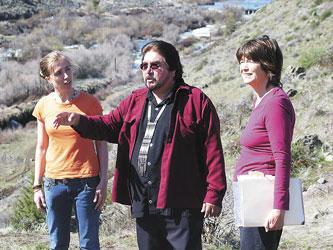|
http://www.heraldandnews.com/articles/2007/03/19/news/local_news/local2.txt
Klamath man recalls the spotted owl's ‘heyday'
 |
 |
H&N photo by
Todd E. Swenson
Brent Frazier, 59, recalls his days
working for the BLM and the U.S.
Forest Service for the Fremont-Winema
National Forests. |
|
| |
March 19, 2007, Steve
Kadel, Herald and News
Nothing symbolized Brent Frazier's 18-year
career with the Fremont-Winema National
Forests more than the spotted owl.
It was the most
publicized species protected under the
Northwest Forest Plan. That meant a huge
decline in timber harvest during Frazier's 18
years as a wildlife program manager for the
Fremont-Winema.
Frazier, recently retired from the Forest
Service, said the Fremont's annual cut dropped
from 60 million board feet a year to about 17
million during what he calls the “heyday” of
the owl.
There were other
critters protected by the forest plan, too.
Invertebrates and even fungi were considered
before offering timber sales on federal land.
“There were many species, but the spotted own
was the surrogate,” Frazier said.
Timber managers had to know which species
existed in the proposed sale area, and how
logging would affect their survival.
“You're literally crawling on the forest floor
looking for things,” he said.
The process added “a tremendous amount of
expense” to timber sales, Frazier said.
Often the price was too steep for many timber
firms to pay, and sales weren't executed.
Forest managers were challenged simply to find
a process for determining how many of a
particular species existed.
“How do you survey for
the slug?” Frazier said.
Financial hardship
He can chuckle about it now, but the spotted
owl days were grimly serious in the 1980s and
‘90s when entire communities - particularly on
Oregon's west side - depended on high harvest
levels for economic survival.
However, it wasn't a new experience for
Frazier.
“When I started with
the BLM it was bald eagles,” he said of his
work in northern Idaho.
He developed winter range management plans for
elk in that job. When a reduction in staffing
was imminent, he moved to Pendleton as
planning biologist with the Umatilla National
Forest.
His next step was to
the North Fork John Day Ranger District, where
he was a jack of all trades, managing soils,
water and fisheries. Frazier spent five years
there before moving to Klamath Falls in 1989.
“When I got here, the Fremont-Winema was just
finishing its forest plan,” he said.
That document guides
all aspects of forest use, usually with a
lifespan of about 15 years. A new Fremont-Winema
plan was due to begin two years ago, but
Frazier said lack of funding has prevented it
from starting.
Outdoor science school
Frazier was drawn to
the outdoors as a child, participating in Boy
Scout camping trips and other adventures.
Wildlife management became his career choice
in college when he realized he lacked ability
for his initial goal of becoming a physicist.
He now holds bachelor's and master's degrees
in biology from Portland State University.
In semi-retirement, Frazier has become
executive director of the Klamath Outdoor
Science School. It provides hands-on science
training for fourth- through sixth-graders,
with students camping for three day
instruction periods in yurts on Sun Pass State
Forest 45 miles north of Klamath Falls.
Frazier said there is an almost unlimited
supply of local volunteers to help the staff
of four teachers.
“In the Basin we probably have more wildlife
and fisheries biologists than anywhere,” he
said.
|

